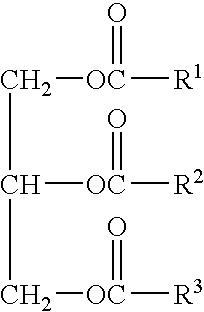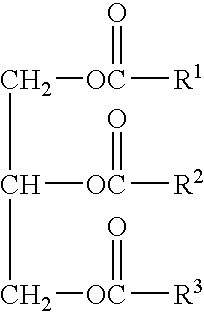Soy protein containing food product and process for preparing same
a technology of soy protein and food product, which is applied in the field of soy protein containing food product and a process for preparing the same, can solve the problems of unsatisfactory taste of analog products, and inability to meet the needs of consumers, etc., and achieves the effect of reducing the cost of beef, reducing the risk of allergic reactions, and reducing the number of calories
- Summary
- Abstract
- Description
- Claims
- Application Information
AI Technical Summary
Problems solved by technology
Method used
Image
Examples
example 1
[0129] Added to a vessel are 6 grams Colormaker Red No. 5417 colorant available from Colormaker Anaheim, Calif. and 300 grams of a first portion of hydration water. The colorant is permitted to hydrate for 0.3 hours while stirring. Then added are 150 grams of a dried low moisture (7% to 12%) fibrous material. The fibrous material is permitted to hydrate for 0.3 hours while stirring. Stirring is continued and added are 50 grams beef bouillon, 13.5 grams egg albumin, 13.5 grams canola oil, 4.5 grams caramel color, 2.4 grams Natural Flavor Enhancer, 1.2 grams shitake extract and 100 grams of a second portion of hydration water. These ingredients are blended to obtain a thorough mixture. The mixture is then formed into slabs, strips, cutlets, patties or steaks as desired. This formation is carried out by hand or by machine. The formation is roasted at 300° C. to an internal temperature of 70° C. The roasted formation is permitted to cool to give to a meat free soy protein containing foo...
example 2
[0130] Added to a vessel are 300 grams of hydration water followed by 150 grams of a dried low moisture (7% to 12%) fibrous material. The fibrous material is permitted to hydrate for 0.3 hours while stirring. Stirring is continued and added are 50 grams beef bouillon, 13.5 grams egg albumin, 13.5 grams canola oil, 4.5 grams caramel color, 2.4 grams Natural Flavor Enhancer, and 1.2 grams shitake extract. These ingredients are blended to obtain a thorough mixture. The mixture is then formed into slabs, strips, cutlets, patties or steaks as desired. This formation is carried out by hand or by machine. The formation is roasted at 300° C. to an internal temperature of 70° C. The roasted formation is permitted to cool to give to a meat free soy protein containing food product having the color appearance of a cooked medium rare steak.
example 3
[0131] Added to a first vessel are 10 grams Colormaker Red No. 5417 colorant available from Colormaker Anaheim, Calif. and 450 grams of a first portion of hydration water. The colorant is permitted to hydrate for 0.3 hours while stirring. Then added are 225 grams of a dried low moisture (7% to 12%) fibrous material. The fibrous material is permitted to hydrate for 0.3 hours while stirring. Added to a second vessel are 250 grams of a 3 mm grind of a beef 90, 10 grams of sodium chloride, 0.1 gram of sodium nitrite, 0.25 grams of sodium erythorbate, 3 grams of sodium tripolyphosphate and 50 grams of a second portion of hydration water. After the contents of both vessels are thoroughly combined, the contents of the first vessel are added to the second vessel. The contents are blended to obtain a thorough mixture. The mixture is then formed into slabs, strips, cutlets, patties or steaks as desired. This formation is carried out by hand or by machine. A beef fat of 50 grams of a 3 mm grin...
PUM
| Property | Measurement | Unit |
|---|---|---|
| Volume | aaaaa | aaaaa |
| Weight | aaaaa | aaaaa |
| pH | aaaaa | aaaaa |
Abstract
Description
Claims
Application Information
 Login to View More
Login to View More - R&D
- Intellectual Property
- Life Sciences
- Materials
- Tech Scout
- Unparalleled Data Quality
- Higher Quality Content
- 60% Fewer Hallucinations
Browse by: Latest US Patents, China's latest patents, Technical Efficacy Thesaurus, Application Domain, Technology Topic, Popular Technical Reports.
© 2025 PatSnap. All rights reserved.Legal|Privacy policy|Modern Slavery Act Transparency Statement|Sitemap|About US| Contact US: help@patsnap.com



